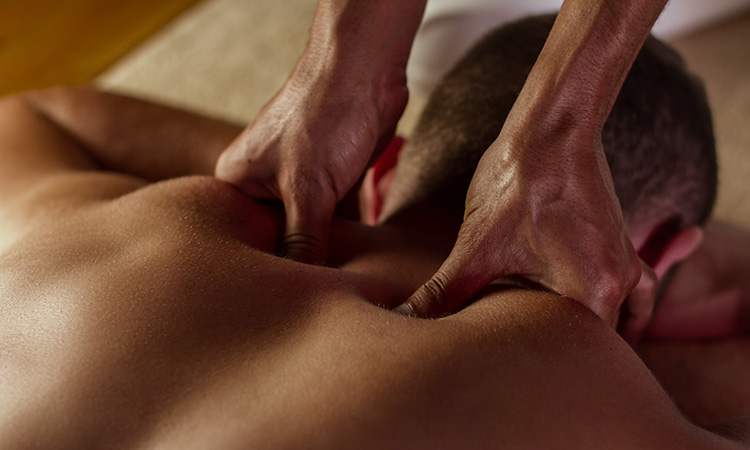As an educator, author Jimmy Gialelis often speaks with massage therapists in his classroom about the perspectives of massage their clients hold true. This article will delve into six common massage myths held by clients. Gialelis has selected client-held myths that are commonly related to him by fellow massage therapists.
1. “Massage has to be deep to be effective.”
Many clients express their belief that massage has to be deep to be effective—but deep pressure is a subjective idea. Proper communication is necessary to ensure safe application of deeper pressure. It is important to express that hurting a client to the point their body elicits a sympathetic response I counterproductive. Healing cannot occur during a fight, flight or freeze response.
Also, a massage therapist needs to discuss how a client interprets the concept of deep tissue. Does the term deep tissue mean more pressure or precise pressure? Does the term refer to specific pain regions within the body? What are the expectations of a client with this term? Ensuring both the therapist and client are matching interpretations of the term deep tissue can avoid confusion and unrealized expectations.

2. “No massage during the first trimester of pregnancy.”
This myth has been dispelled many years ago with a caveat attached. The American Pregnancy Association confirms on its website that “women can begin massage therapy at any point in their pregnancy—during the first, second or third trimester.”
If a pregnant person has a high-risk factor as determined by the American Medical Association, then caution needs to be applied. This is true for a pregnant person within any trimester. A pregnant person with no high-risk factors, experiencing a healthy pregnancy, can receive a massage in any trimester.
However, a well-trained massage therapist will ask about high-risk factors during the intake process to determine if the client falls under the high-risk category.
These factors include:
autoimmune disease; COVID-19; diabetes; disease of the heart, kidneys, thyroid or reproductive organs; obesity; blood clotting disorders; low body weight (BMI less than 18.5); pregnancy-related health conditions, birth defects or fetal genetic abnormalities; poor growth of fetus; gestational diabetes; preeclampsia or eclampsia; lifestyle factors that worsen health in general, such as smoking, drug addiction or alcohol abuse; age (over 35 or under 17).

3. “Relaxation massage is not therapeutic.”
In common conversation, it is easy for people to describe massage as either relaxation or therapeutic. Relaxation massage is often described as fluff and buff, lighter in pressure application, performed without any specific goals.
Therapeutic massage is often described as getting in there deep, more pressure application, performed with a specific body region of focus. A perspective I will offer is relaxation is among the top therapeutic benefits of massage therapy. When the nervous system calms, the body may enter a parasympathetic state. The body returns to homeostasis in this state. Healing occurs in this state. Be careful with language assuming that lighter touch and relaxing the nervous system cannot be as effective as a deeper touch that excites the nervous system. Help your clients see that their bodies can heal just as effectively (if not more) in the parasympathetic state.

4. “Children and teens do not need massage”
Massage can help anyone at any age. It’s a common misconception that children and teens do not need massage, nor their bodies cannot tolerate massage. Certainly, their tissues may not be as mature as adult tissues; however, children and teens can receive massage therapy to achieve the same benefits as with adults. Typically, sessions do not need to be as long in duration. Also, a massage therapist needs to be sensitive to how the child or teen is receiving massage.
There is much research conducted by the Touch Research Institute at the University of Miami, Florida highlighting the efficacy of massage therapy for children and teens. One example is a study by the Touch Research Institute highlighting how massage improved motor function and muscle tone in children with Down’s Syndrome. Two 30-minute massages provided weekly over a two-month period improved muscle function and tonicity.
5. “Massage therapy is not as effective as physical therapy.”
When a client states this idea, it seems they are insinuating massage therapy as merely relaxing whereas the physical therapy is doing therapeutic work that addresses the issue directly. A well-trained massage therapist needs to educate clients how their massage efforts are directly addressing a client’s physical needs.
Take the time to discuss the modalities, approaches and intentions of massages when working with clients in need of physical therapy. Show how massage and physical therapies complement each other in achieving client goals.
6. “It hurts here, so the problem must be here.”
It is understandable why the general public would think this way. If someone has suffered an injury in a certain region, there will be associated pain, inflammation and loss of function of the injured region; however, after the acute and subacute phases of injury, the body will adapt to compensate for dysfunction or acquired weakness of the affected region.
The compensation patterns will manifest challenges elsewhere in the body over time if a client does not engage in regular massage or exercise routines.

About the Author
Jimmy Gialelis, LMT, BCTMB, is owner of Advanced Massage Arts & Education in Tempe, Arizona. He is a National Certification Board for Therapeutic Massage & Bodywork-approved provider of continuing education, and teaches “Gua Sha: Chinese Scraping Method” and many other CE classes. His many articles written for this publication include “The Problem with Pickleball: Popular Sport is Serving Up Injuries” (massagemag.com).
